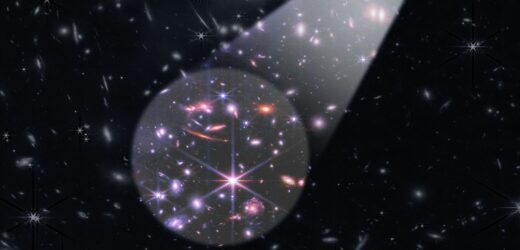Photo illustration: Aïda Amer/Axios. Photo: NASA, ESA, CSA, and STScI
NASA's James Webb Space Telescope has spotted six possible galaxies that scientists say are too large for the early universe.
Why it matters: If these galaxies are confirmed as real, it could force scientists to re-examine their models explaining how the universe has evolved.
- One of the major tasks for the JWST is to figure out how the first generations of galaxies came together after the Big Bang.
- By peering deep into the early universe, the telescope is helping scientists learn more about that epoch of the cosmos.
What they found: A new study in the journal Nature suggests six galaxy candidates appear to have about as many stars as our Milky Way but formed just 500 million to 700 million years after the Big Bang.
- "It’s bananas," the University of Colorado Boulder's Erica Nelson, an author of the new study, said in a statement. "You just don’t expect the early universe to be able to organize itself that quickly. These galaxies should not have had time to form."
But, but, but: There could still be other explanations for how these strange objects in distant space came to be.
- It's possible these galaxies have supermassive black holes feeding off of gas and other matter, making them shine brightly in JWST's data. But they may not have as many stars as the telescope data suggests.
- “The formation and growth of black holes at these early times is really not well understood," Emma Curtis-Lake of the University of Hertfordshire, who wasn't involved in the new study, tells ScienceNews.
- "There’s not a tension with cosmology there, just new physics to be understood of how they can form and grow, and we just never had the data before."
What's next: Scientists will need followup observations using the JWST to learn more about what exactly is going on with these objects.
- The JWST is able to take spectra — effectively chemical fingerprints — of galaxies to determine their compositions.
- “A spectrum will immediately tell us whether or not these things are real,” Penn State University's Joel Leja, an author of the study, said in a statement. “It will show us how big they are, how far away they are."
Source: Read Full Article



